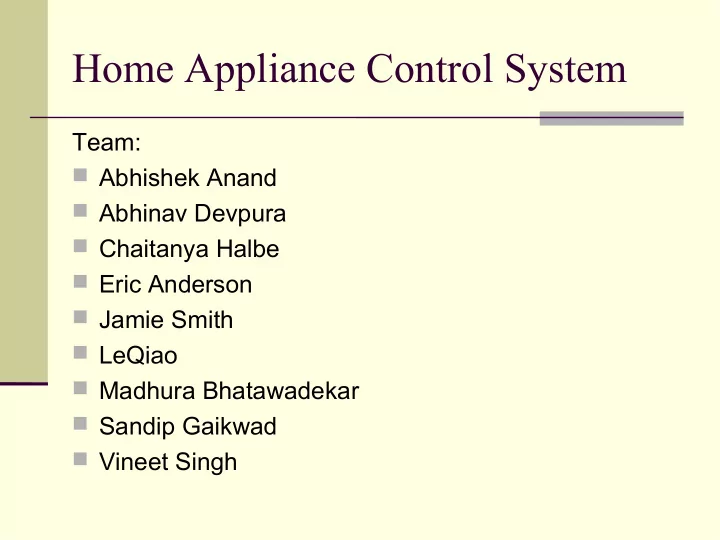

Home Appliance Control System Team: Abhishek Anand Abhinav Devpura Chaitanya Halbe Eric Anderson Jamie Smith LeQiao Madhura Bhatawadekar Sandip Gaikwad Vineet Singh
Topics to Discuss Introduction Interface Architecture and Design Conclusion
Introduction
Why HACS?
Introduction What is a HAC System? Why HAC? Saves time Saves money (long run) Self maintenance Security Makes life easy
Why HACS?
Introduction Preexisting HAC Systems Wired/Wireless Centralized/Distributed
Interface
Services provided by HACS Browse all devices Select a particular device to get or set its status Categorize the devices according to functionality/location Provide security to device options Notifications sent by devices to user
Master Use Case
Class Diagram
Sequence Diagram
Example
Architecture and Design
Extensibility Standard Networking Preexisting Protocols “Do one thing and do it well” Distributed Controller Device
Ease of Installation and Use Standard Networking Ubiquitous Service Discovery Metadata UPnP Zeroconf Generic Device Protocol property name, data type, value SNMP
Cost of Installation and Use Standard Networking Ubiquitous Stateless Protocol UDP Two Tier Smart Device Dumb Device More Extensibility
Communication Mediums 1 st Tier Communication 2 nd Tier Communication Ethernet USB 802.11 (Wireless) Bluetooth Optical Fiber! Firewire Electric Outlets Infra-red Other Serial (COM) Port Internet 1-wire bus Radio Mobile Device String Morse Code
Standard Networking Side-effects Speed Reuse Simplicity Security
Reuse
Simplicity
Simplicity
Simplicity
Access Control Property based Pin number
Poll v Event Microwave Fire alarm Support both
Tool for the Interface
Conclusion
Conclusion What we have done Use case diagram, sequence diagram, class diagram, domain analyze. What we will do Implement the web interface, networking.
Conclusion Key point and highlight of our project Good balance between the extensibility and cost Distributed system What we learned It’s team work Use diagrams to help with building the system
Question and Answer “You've got questions, we've got answers.”
Recommend
More recommend